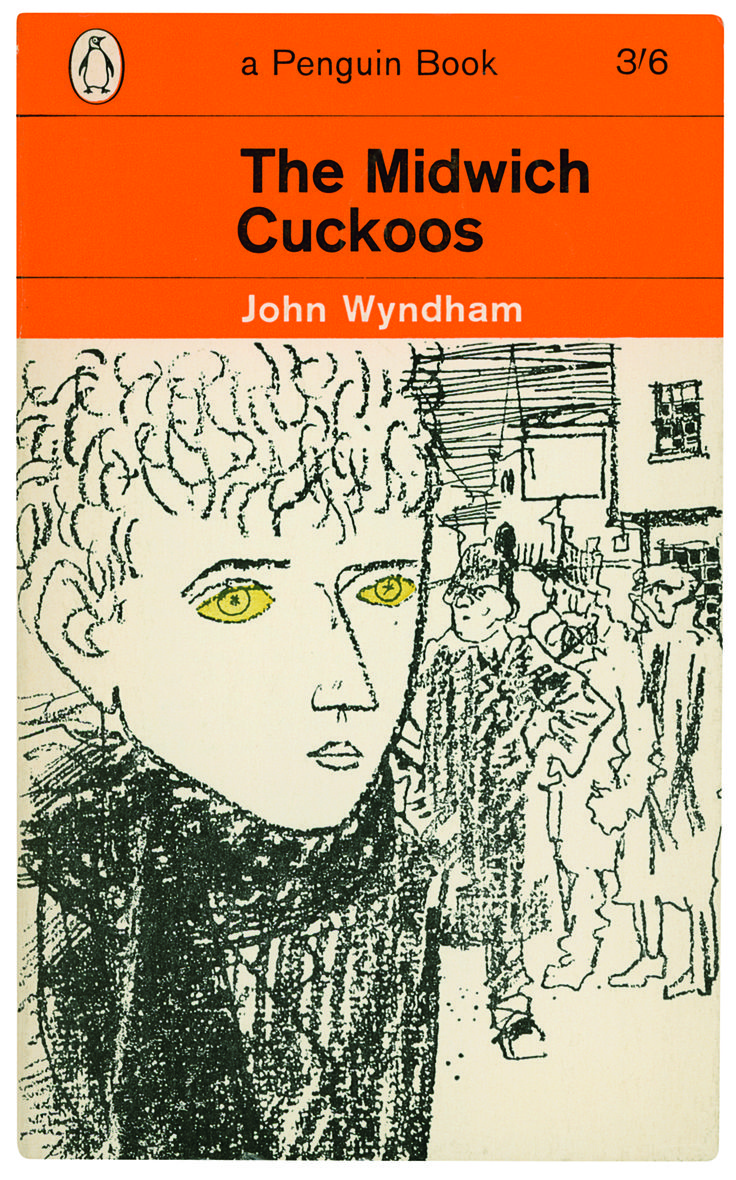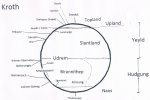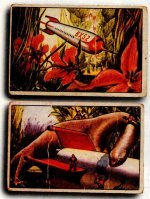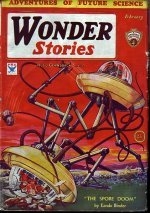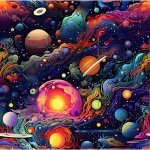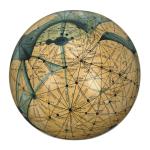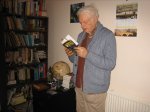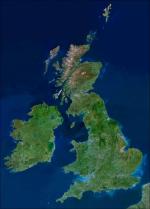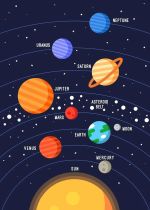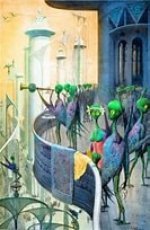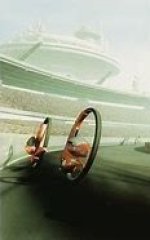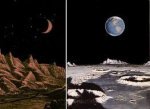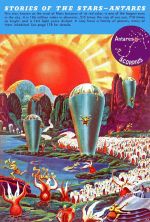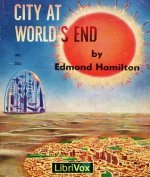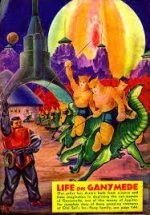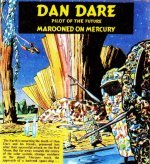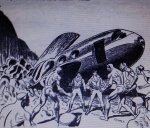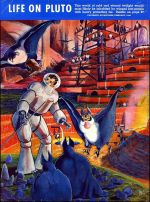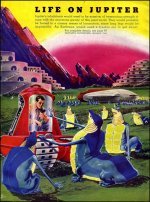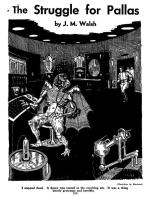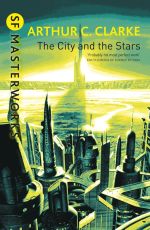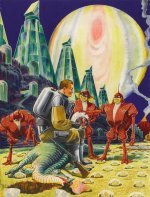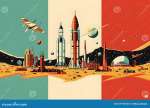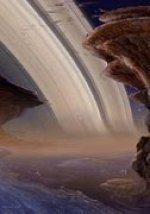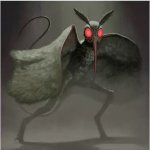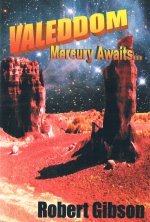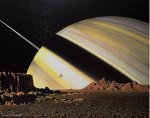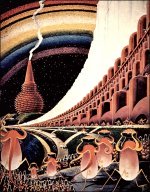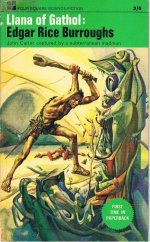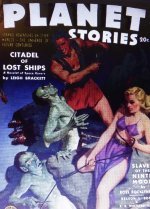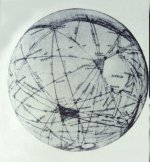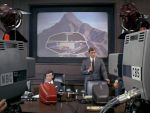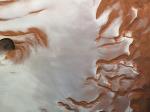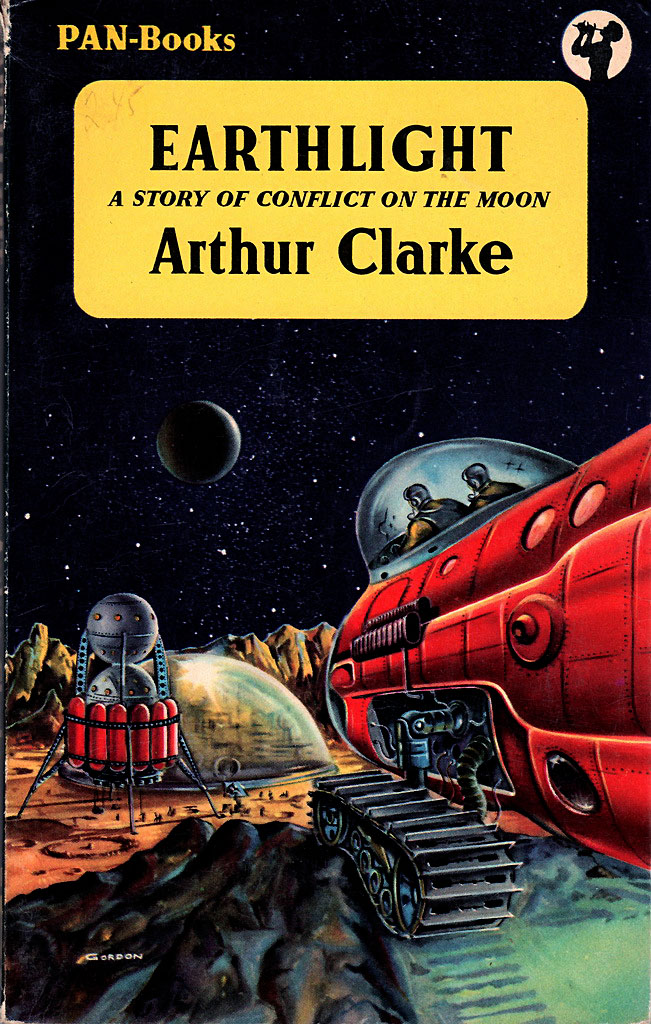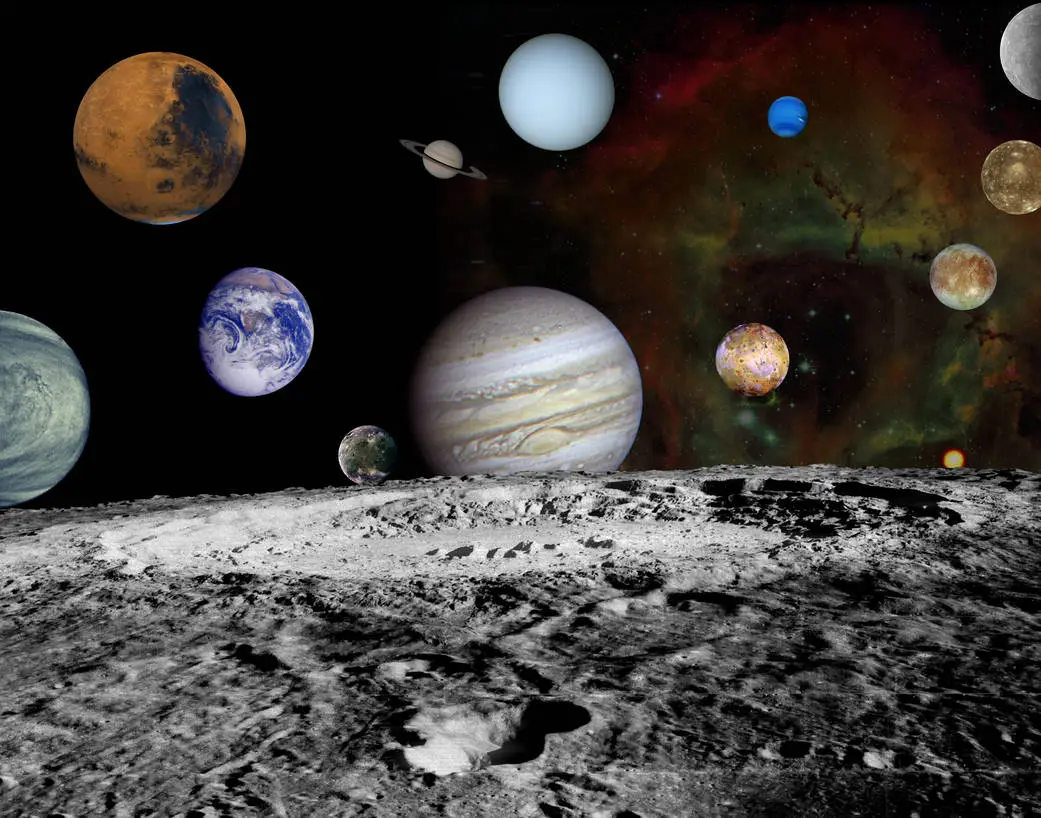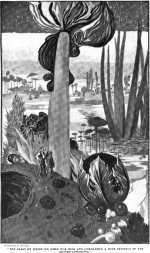a brief history of ooranye
1: the hydrogen era

Only the slight brush of a cold breeze disturbed the lake. Sparse leaves rustled on the scrubby plain beyond, while the waves sloshed gently against the shoreline, as they waited for History.
The scene was deserted by all heavy creatures. Nothing came to drink the oddly muttering waters; the ice-chocked landscape remained un-crunched by any footprint so far.
Then came change.
The waters on that morning did more than mutter. They started to seethe; and the beginning began.
In this beginning, Dmara was not even a name; Dmara was a bubbling prebiotic lake or sivvan, in an icy crater on a shaggy brittlegrass plain. However – and here is the hard-science, causative way to tell it –
“Evolution surged in the lake, driven by churned emanations, sparked from close brushes with mascon matter during its near-surface convection in the planet’s mantle…”
A different authority, after quoting this passage, says:
“Or you can put it the other, less materialist, the result-pulled way:
“The force of destiny, breathing out from Ooranye and hanging over it like an atmosphere, had, like an atmosphere, its storms and twisters; one of these concentrations condensed into an ‘effect’, and around ‘effect’ then clustered ‘cause’; Excuse was born, an excuse called evolution.”
Whichever way you narrate the event, patter patter go the words, to tell your acquiescent mind that something happened to produce the first beings to emerge from the lake of Dmara.
In outline the Liquid Men (“Dmarnenn”) were human. Likewise their minds were a kind of silhouette of ours. They were more mature than the subsequent first true men, but their natures remained simpler, one might say “purer”, at any rate more focused upon a clear and narrow destiny.
Their “skin” was not skin as we know it. It was a form-field, which needed frequent immersion to maintain its integrity. They did not eat, as humans eat; their food was the sivvan’s radiation, which dimmed with increasing distance from its source. So these beings could not exist for long outside that lake. Eventually, as the sivvan began to dry up, the Liquid Men were doomed.
What they yearned to see before they became extinct was the evolution of an heir who could leave Dmara’s shores permanently, and roam the world. Somehow this was done. They never showed how. All we have for certain is their confession, that the task was accomplished by cheating Time.
We can deduce that to borrow an energy-pattern from the future must have entailed using some transcendent power latent in the sivvan; be that as it may, the goal, to transform a swimming glow of form-fields into a fully material human being, took shape as Lrar the Verzaknenn or first true man. The date of the solidification of his skin-tissue was Day One of the Hydrogen Era.
Note carefully, that when we say that Lrar Verzak, the Uranian Adam, the ancestor of all Nenns, appeared on Day One of the Hydrogen Era, we are not merely labelling the date for our own convenience. We mean that Lrar himself knew, right then, that that was the day.
He knew it because knowledge of the periodic table of the elements is innate in Uranian man, and because, due to the teleological slant of the Uranian soul, it was known from the start that there would be 92 eras. With that number, and that knowledge, how else should the eras be named? Thus chemistry clasps history on Ooranye. Compared with us Earth humans, the Uranian humans – the Nenns – feel a closer kinship with so-called inorganic matter. It is a hylozoic sense that everything is in some sense alive. One can see how such a sense might stem from greater closeness to, or more direct descent from, the primal chemical mixture. And so the blaze of primitive legend, which haunts the origins of things on Earth, has the added fascination, on Ooranye, of being recorded. In other words, on that world the magic of prehistory has been captured for history.
At this point we should also mention, that Man was not the only species to emerge from the sivvan on that Day One.
From the same moment onwards, a host of aerial bacteria, their faint glow pulsating in a thirty-hour rhythm, swarmed out over the planet to give it its cycle of night and day. Ever since then, throughout the ages that followed, there has been a relationship between this aerial biomass and human emotions, because the biomass rhythms are sensitive to mass emotion. That is why great events trigger irregularities (called eomasps) in the diurnal cycle, and why these rare ‘blips’ in the rhythm of day and night signal the start of new eras.
Now for an overview of the First Era.
As well as being the first, the Hydrogen was one of the great eras. It lasted 19,636,085 Uranian days (each of their days, remember, is thirty hours, i.e. one and a quarter Earth days long), which means it lasted about 800 Uranian years, or the equivalent of 67,200 Earth years. Rather than attempt a continuous narrative of this ocean of time, we will sketch three verbal pictures, centred around the early, the middle and the later days.
The early days:
The scene which met the eyes of the first Nenn – the first true Uranian Man – as he walked away from the lake was utterly different from that which the tourist or pilgrim sees today. Instead of the current view of the old city encircled by the bare, multi-coloured plain of granular gralm, Lrar Verzak saw grass and forest, although the grass was slowly dying, the forest brittle, pallid, close to the end of its species lifetime. Huge soon-to-be-extinct animals roamed the grassland and crashed through the splintering trees as Lrar gazed about him. Sentient plants writhed and spat. Giant insects swooped and hummed. Long lists of their names have come down to us – names which popped into the minds of Lrar and his later companions and successors, each word full-formed after one authoritative glance.
Two species in particular, the Wonarr and the Revestru, deserve mention because they were intelligent as well as destructive. They did not go out of their way to attack Man; they were intent upon attacking each other, vying for supremacy to the very last, while the sands of time ran out for both of them. The Wonarr were a species of laser-tipped weed, whose less intelligent relatives the narps still exist upon Ooranye; the Revestru were a variety of insectoid, somewhat resembling giant wasps, and related to the later Nemaeans. Humans caught in the crossfire of the conflict could only try to keep their heads down and dodge the laser bolts and the diving swarms.
For a few days after the emergence of Lrar Verzak, more humans, male and female, followed him out of the lake. They and their descendants ranged gradually further and further from Dmara (a name which in this age referred only to the lake; the city was not yet built). The invention of writing occurred after a few generations; early enough to preserve accurate and detailed accounts of the beginning.
Meanwhile the Liquid Men, kindly demigods whom the Nenns consulted at will, declined gradually in numbers.
Knowing that they faced eventual extinction as their lake shrank in size and decreased in power, the Liquid Men never ceased to plan. They were not yet in any great hurry; the evening of their days was long, and so their view likewise was long. They regarded the Nenns, the solid humans, as their legitimate successors, even in some sense their children. So in order to help these “children” to survive, many Liquid Men began in leisurely fashion to employ their greater intelligence to show true men how to scavenge metals and tools from relics left behind by extinct races of previous Great Cycles. Immense rusty wheels and girders, pipes and tracks, outnumbered by far more incomprehensible objects, were hauled through the grass for lifetime after lifetime, by men and women instructed or variously inspired by the Dmarnenn. The gear was brought to the lakeside of Dmara and heaped into one great store of building material. Here the Liquid Men showed the Nenns how to construct the First City around the shores of the dying sivvan. From this they learned also to build elsewhere, later, for themselves.
The middle days:
Insofar as it relied upon a limited supply of the treasures of the past, the industry of the Hydrogen Era was perforce a low-energy affair. There is little coal on Ooranye; no petroleum; nowhere on the vast plains are there rivers for waterwheels or hydroelectric power. Technological development on Ooranye must leap past such things, and in this era the leap was not generally made, though eventually some ores were obtained from the Mountains of Flame, and smelted under the guidance of the Dmarans at the world’s single furnace.
However, there is one big exception to this modest economy. In rare cases, humans succeeded in tapping resources which the Liquid Men could not or would not touch. A few human adepts in this period already knew, psychically, how to draw power from Chelth, the “invisible land”. Chelth was in fact another dimension, a different universe. It was that universe later plundered wholesale in the Sodium Era – the episode which was to cause so much trouble and heart-searching later on, as Uranians risked the guilt of depleting a foreign cosmos for the sake of augmenting their own world. But for the time being, the adepts were highly regarded. These early power-suckers helped to lift certain small patches of their civilization securely above Earth’s medieval level. Typical of the middle period of the Hydrogen Era was the balloon-tyred dray, hauling goods across the plains, fuelled by a power-cell bought at great expense from a dynasty of petty psychics.
The cities of this period were conical mounds, growing around the rare groves of young plant species, splashes of brighter green amidst the older, dying ecologies. In the vegetable kingdom, the ebb of the old Great Cycle was overlapping with the rise of the new.
The cities were mostly independent of one another, but some of the more powerful ones – including five that stood on the sites, and bore the names, of later disc-on-stem cities of the Phosphorus Era – formed leagues or even empires. The five cities of today that can thus trace their names (though not their physical identities) back to the mid-Hydrogen Era are: Innb, Ao, Hoog, Nuvium and Pjourth. It is hard for us, when we read their fantastically early history, not to visualise their inhabitants as tiny forms seen through the wrong end of a telescope.
One ironic, even comic aspect of the long Hydrogen Era may be mentioned here, in passing. The Nenns knew there would be 92 eras, that is to say, 91 following the first one, but as time went on many believed that the first would be the only long one, and that all the rest would then pass quickly in a staccato burst of rapid changes prefiguring the end. This belief went hand in hand with a sense that the world and mankind were getting old, Time itself was getting old… for after all, look at how much had happened, how much was past, how thick the layer of history underfoot. – So, laughably, went the thoughts of many people during the earliest dawn of the human saga on Ooranye.
The latter days:
During the last part of Era One it became apparent that some fear was gripping the Liquid Men. We have a four-letter word for this thing, which they were loath to mention.
Debt.
The records are unclear as to how far they thought of it as a personal debt, and how far “debt” was here a metaphor for the way Nature must “balance her books” as we might say when talking of the law of conservation of energy. Be that as it may, the awkward fact was that, way back at the start of the era, they had, in some sense which we do not understand, “borrowed energy from the future” in order to trigger the emergence on Ooranye of true Man. Now the terrible term payback began to haunt them. A deadline began to loom in their dreams.
We know all this because, during the course of millions of days, a few of these great beings uncharacteristically let slip their anxieties. Ordinary Nenn humans, puzzled and appalled by the vague nightmarish sayings of their mentors, then reacted by loosening their own sentimental ties to Dmara, as children will edge away from parents who seem to have gone cold with anxiety. This was the age of the so-called “long march to Contahl”, really a fissiparous, spontaneous spread of the human species over a wide area of what was to become Syoom. Contahl was at first merely one of many new cities founded as the area under human occupation (or at least the area seen by human eyes) increased from around ten million to close on four hundred million square miles.
Obviously, this mass movement – best termed the Great Dispersion – was of supreme importance for the future of humanity on Ooranye. It eventually meant that as much as a fifth of the globe was colonized, albeit thinly. But two results were of greater immediate significance.
Firstly, the scattering of mankind called forth a political reaction among the more long-established states. For a mixture of motives, they deplored the ramshackle sprawl of pioneering cultures, and sought to limit their expansion and their freedom by bringing them under centralized control.
There was an excuse for this restrictive policy. In many cases whole communities of pioneers, trying to cope with the strangeness of much of Ooranye, had “gone native”. This meant loss of their own species identity as their mentalities adapted away from the human; in some cases they became literally twisted out of shape, or even surrendered to evolutionary mergers with other species, so that subsequent visitors to the area might hear voices in their own language issuing from mounds or bulbous groves where no human forms could be seen. So the horrified city governments may be excused some of their violent reaction. Nevertheless, their tyrannous attempts at enforcing their will, and the sagas of resistance which we have no space to consider here, gave political unity a bad name from which it has never recovered in all the long eras of Uranian history.
The second immediate result of the Great Dispersion was that it called forth a last great altruistic effort on the part of the Dmarnenn.
The Liquid Men were now ageing rapidly as a species. When they realized that they were “on the last lap” of their history, with their remaining days numbered in six figures or less, they concentrated their minds upon a practical problem hitherto thought to be unsolvable. They had always assumed that they could never travel far from Dmara. Now they began to search for a way of doing just that. They felt that they must at all costs free themselves from dependency on their lake, and acquire the ability to roam as widely as humans could, if they were to use their final span of life to bring peace to mankind and set the Nenns on the path to greatness.
The aim was achieved with the design of a flexi-suit adapted to the Dmaran form, and energized with a concentrate from the sivvan. This at last enabled the remaining Liquid Men to journey thousands of miles from Dmara.
It seems, according to the best evidence we have, that they then fulfilled their ambition of giving decisive help to mankind. For one of these benevolent wandering Dmarans, having trekked as far as the region of Contahl, apparently gave a crucial hint to the great discoverer, Tisswa Ardea.
Tisswa’s testament relates that in a dream (if it was a dream) she heard the Dmaran whisper in her ear, as he pointed to a rounded mountain in the distance, “Yonder seek your power”. And next day she took a pickaxe and a box for samples, and set out alone towards the mountain.
When
she reached the top she set to work with the pickaxe. Chips of ordinary rock flew
this way and that until a glowing orange substance was revealed. Her chemical intuition
– a faculty we Earth humans do not possess – told her what this stuff was: a lattice
of atomic particles embedded in a non-atomic medium. She gathered samples and returned
to Contahl, carrying the fate of her species in her hands. For what she had found
was the greatest and most dangerous boon to fall to Uranian Man up to that time:
a mascon of semi-kolv or gvo, several
hundred yards in diameter, which convection had brought right up to the planet’s
surface. That is to say she had found a source of solid power which would supply
the needs of a stepped-up civilization for over 200 Uranian years (over 19,000 Earth
years). And then it would be gone, and so humanity, launched upon a path to fuel-hungry
greatness, would have to find something else…. An irresistible, game-raising temptation.
Continued in: 2. Syoom and Fyaym
